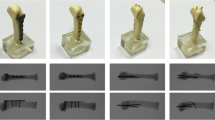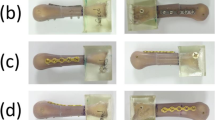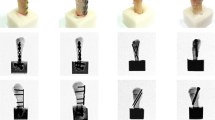Abstract
Purpose
In this study, the fixation strength of the new cross locking plate for metacarpal neck fracture was compared with Kirschner-wire (K-wire) or traditional dorsal locking plate.
Methods
Transverse metacarpal neck fracture models were created on 24 artificial metacarpal bone specimens using saw blade. The specimens were then divided into three groups of different fixation methods: (1) Two K wires (KW group); (2) Traditional dorsal locking plate (TP group); and (3) New cross locking plate (NP group). All specimens were examined with cantilever bending test on a material testing system, and the maximum fracture force and stiffness were used as indicators to evaluate the facture fixation strength. The results were compared using a one-way analysis of variance and Tukey test for post hoc analysis.
Results
For the maximum fracture force, the fixation capacities of the three metacarpal neck fracture groups were ranked as follows: TP group (355.8±42.5 N, mean±standard deviation)≅NP group (353.9±49.3 N) > KW group (193.3±32.8 N). For stiffness, the fixation capacities of the three groups were ranked as follows: TP group (69.0±4.8 N/mm)≅NP group (64.2±6.3 N) > KW group (27.0±5.8 N).
Conclusion
The fixation strength of the new cross locking plate was similar to that of the traditional dorsal locking plate and was substantially higher than that achieved when only two K-wires were used. In addition, the new cross locking plate may reduce the occurrence of tendon adhesion, joint stiffness, and the screws being pulled out from the metacarpal head, which can be caused by traditional dorsal locking plates.







Similar content being viewed by others
Availability of data and material
The data sets used and analyzed during the current study are available from the corresponding author upon reasonable request.
References
Van Onselen, E., Karim, R., Hage, J. J., & Ritt, M. (2003). Prevalence and distribution of hand fractures,. Journal of Hand Surgery, 28, 491–495
Thurston, A. (1992). “Pivot osteotomy for the correction of malunion of metacarpal neck fractures,“. The Journal of Hand Surgery: British & European Volume, 17, 580–582
Chen, K. J., Wang, J. P., Yin, C. Y., Huang, H. K., Chang, M. C., & Huang, Y. C. (2020). Fixation of fifth metacarpal neck fractures: a comparison of medial locking plates with intramedullary K-wires,. Journal of Hand Surgery (European Volume), 45, 567–573
Kim, J. K., & Kim, D. J. (2015). Antegrade intramedullary pinning versus retrograde intramedullary pinning for displaced fifth metacarpal neck fractures,. Clinical Orthopaedics and Related Research®, 473, 1747–1754
Botte, M. J., Davis, J., Rose, B. A., von Schroeder, H. P., Gellman, H., Zinberg, E. M., & Abrams, R. A. (1992). “Complications of smooth pin fixation of fractures and dislocations in the hand and wrist,“Clinical Orthopaedics and Related Research,194–201,
Jones, C. M., Padegimas, E. M., Weikert, N., Greulich, S., Ilyas, A. M., & Siegler, S. (2019). Headless screw fixation of metacarpal neck fractures: a mechanical comparative analysis,. Hand, 14, 187–192
Jones, W. W. (1987). “Biomechanics of small bone fixation,“Clinical orthopaedics and related research,11–18,
Padegimas, E. M., Warrender, W. J., Jones, C. M., & Ilyas, A. M. (2016). “Metacarpal neck fractures: a review of surgical indications and techniques,“Archives of trauma research,5:
Boeckstyns, M. E. (2021). Challenging the dogma: severely angulated neck fractures of the fifth metacarpal must be treated surgically,. Journal of Hand Surgery (European Volume), 46, 30–36
Chong, H. H., Hau, M. Y., Shah, R., & Singh, H. (2020). Management of Little Finger Metacarpal Fractures: A Meta-Analysis of the Current Evidence,. The Journal of Hand Surgery (Asian-Pacific Volume), 25, 281–290
Zong, S. L., Zhao, G., Su, L. X., Liang, W. D., Li, L. G., Cheng, G. … Li, L. D. (2016). “Treatments for the fifth metacarpal neck fractures: a network meta-analysis of randomized controlled trials,“ Medicine,95:
Barr, C., Behn, A. W., & Yao, J. (2013). Plating of metacarpal fractures with locked or nonlocked screws, a biomechanical study: how many cortices are really necessary?,. Hand, 8, 454–459
Chiu, Y. C., Tsai, M. T., Hsu, C. E., Hsu, H. C., Huang, H. L., & Hsu, J. T. (2018). New fixation approach for transverse metacarpal neck fracture: a biomechanical study,. Journal of orthopaedic surgery and research, 13, 1–7
Doht, S., Meffert, R. H., Raschke, M. J., Blunk, T., & Ochman, S. (2014). “Biomechanical analysis of the efficacy of locking plates during cyclic loading in metacarpal fractures,“The Scientific World Journal,2014:
Elfar, J., Stanbury, S., Menorca, R. M. G., & Reed, J. D. (2014). Composite bone models in orthopaedic surgery research and education,. The Journal of the American Academy of Orthopaedic Surgeons, 22, 111
Malasitt, P., Owen, J. R., Tremblay, M. A., Wayne, J. S., & Isaacs, J. E. (2015). Fixation for metacarpal neck fracture: a biomechanical study,. Hand, 10, 438–443
“American Society for Testing and Materials A. ASTM F1839–08 standard Specification for Rigid Polyurethane Foam for Useas a Standard Material for Testing Orthopedic Devices and Instruments.,“
Watt, A. J., Ching, R. P., & Huang, J. I. (2015). Biomechanical evaluation of metacarpal fracture fixation: application of a 90 internal fixation model,. Hand, 10, 94–99
Chiu, Y. C., Ho, T. Y., Hsu, C. E., Ting, Y. N., Tsai, M. T., & Hsu, J. T. (2022). Comparison of the fixation ability between lag screw and bone plate for oblique metacarpal shaft fracture,. Journal of Orthopaedic Surgery and Research, 17, 1–6
Chiu, Y. C., Hsu, C. E., Ho, T. Y., Ting, Y. N., Tsai, M. T., & Hsu, J. T. (2021). Bone plate fixation ability on the dorsal and lateral sides of a metacarpal shaft transverse fracture,. Journal of Orthopaedic Surgery and Research, 16, 1–10
Winter, M., Balaguer, T., Bessiere, C., Carles, M., & Lebreton, E. (2007). Surgical treatment of the boxer’s fracture: transverse pinning versus intramedullary pinning,. Journal of Hand Surgery (European Volume), 32, 709–713
Balaram, A. K., & Bednar, M. S. (2010). Complications after the fractures of metacarpal and phalanges,. Hand clinics, 26, 169–177
Dreyfuss, D., Allon, R., Izacson, N., & Hutt, D. (2019). A comparison of locking plates and intramedullary pinning for fixation of metacarpal shaft fractures,. Hand, 14, 27–33
Ozer, K., Gillani, S., Williams, A., Peterson, S. L., & Morgan, S. (2008). Comparison of intramedullary nailing versus plate-screw fixation of extra-articular metacarpal fractures,. The Journal of hand surgery, 33, 1724–1731
Facca, S., Ramdhian, R., Pelissier, A., Diaconu, M., & Liverneaux, P. (2010). Fifth metacarpal neck fracture fixation: locking plate versus K-wire?,. Orthopaedics & Traumatology: Surgery & Research, 96, 506–512
Fusetti, C., Meyer, H., Borisch, N., Stern, R., Della Santa, D., & Papaloïzos, M. (2002). Complications of plate fixation in metacarpal fractures,. Journal of Trauma and Acute Care Surgery, 52, 535–539
Page, S. M., & Stern, P. J. (1998). Complications and range of motion following plate fixation of metacarpal and phalangeal fractures,. The Journal of hand surgery, 23, 827–832
Bozic, K. J., Perez, L. E., Wilson, D. R., Fitzgibbons, P. G., & Jupiter, J. B. (2001). Mechanical testing of bioresorbable implants for use in metacarpal fracture fixation,. The Journal of hand surgery, 26, 755–761
Curtis, B. D., Fajolu, O., Ruff, M. E., & Litsky, A. S. (2015). Fixation of Metacarpal Shaft Fractures: Biomechanical Comparison of Intramedullary Nail Crossed K-Wires and Plate‐Screw Constructs,. Orthopaedic surgery, 7, 256–260
Liodaki, E., Wendlandt, R., Waizner, K., Schopp, B. E., Mailänder, P., & Stang, F. (2017). “A biomechanical analysis of plate fixation using unicortical and bicortical screws in transverse metacarpal fracture models subjected to 4-point bending and dynamical bending test,“Medicine,96:
Patel, M., Castañeda, P., Campbell, D. H., Putnam, J. G., & McKee, M. D. (2021). “Threaded Intramedullary Nails Are Biomechanically Superior to Crossed K-wires for Metacarpal Neck Fractures,“ HAND,15589447211003182,
Acknowledgements
Not applicable.
Funding
This research was supported by Kuang Tien General Hospital, Taiwan (Kuang Tien 109-04) and China Medical University, Taiwan (CMU110-MF-95).
Author information
Authors and Affiliations
Corresponding author
Ethics declarations
Ethics approval and consent to participate
Not applicable.
Consent for publication
Not applicable.
Conflict of interest
The authors have no financial or personal relationships with people or organizations that could be considered inappropriate for conducting this study.
Additional information
Publisher’s note
Springer Nature remains neutral with regard to jurisdictional claims in published maps and institutional affiliations.
Electronic supplementary material
Below is the link to the electronic supplementary material.
Rights and permissions
About this article
Cite this article
Yang, CY., Liu, TY., Hsu, JT. et al. Biomechanical analysis of new cross locking plates for metacarpal neck fracture. J. Med. Biol. Eng. 42, 404–413 (2022). https://doi.org/10.1007/s40846-022-00713-8
Received:
Revised:
Accepted:
Published:
Issue Date:
DOI: https://doi.org/10.1007/s40846-022-00713-8




